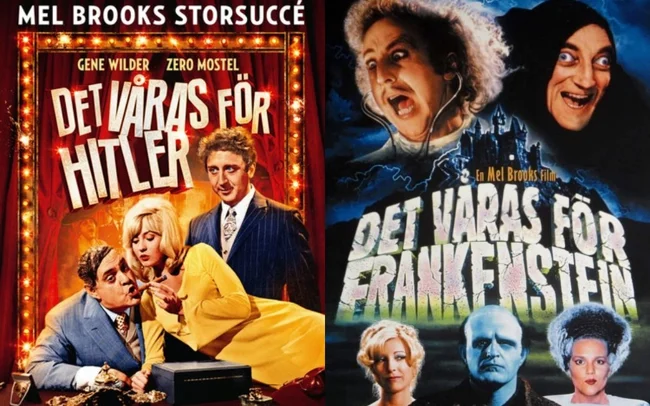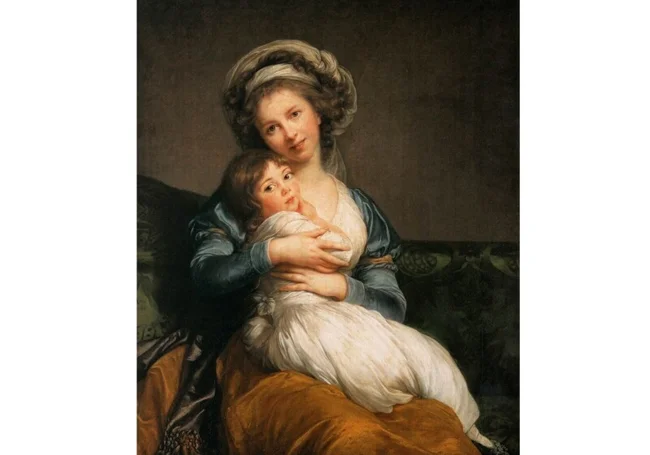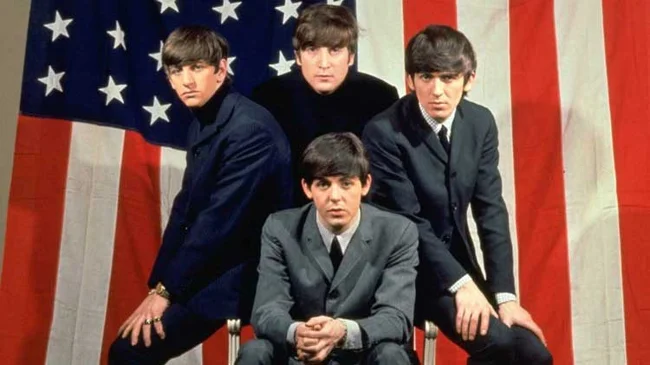Magnificent seven facts about everything in the world (8 photos)
Stories about American hatred, Swedish creativity, German dating, medical jokes and something else. 
Translation in Swedish 
Film lovers know how our distributors distort the titles of foreign films. For example, Taika Waititi’s comedy “What We Do in the Shadows” turned into “Real Ghouls”. But the distributor is the distributor in both France and Sweden. He doesn’t care about the director’s intention, he needs to make sure that the viewer understands everything about the film from just the title. Thus, “Home Alone” at the French box office turned into “Mom, I missed the plane,” and “Home Alone 2” became “Mom, I missed the plane again.” The success of the comedy “Honey, I Shrunk the Kids” (1989) is to blame for this distortion of the title. The French called the remaining episodes of Home Alone in the same style - “Mom, I’ll take care of the bad guys,” “Mom, I’m alone against everyone.”
A similar fate befell almost all of Mel Brooks' films in Sweden. His film debut was originally called “Spring for Hitler,” but the producer forbade commemorating the Fuhrer on posters. That's why in the States the film was called "The Producers." A Swedish critic, an acquaintance of Brooks, obtained permission from the director to use the original title. Thanks to the success of the film, this is what Brooks's filmography in Sweden looks like: "Spring for the Mother-in-Law" (believe it or not, it's "12 Chairs"), "Spring for the Sheriff" (Blazing Saddles), "Spring for Frankenstein" (Young Frankenstein), "Spring for silent cinema" (Silent Cinema), "Spring for Madmen" (Fear of Heights), "Spring for World History. Part 1" (World History. Part 1), "Spring for Hamlet" (To be or not to be), "Spring for space" (Cosmoballs). The Swedes probably think that Brooks is so-so with his imagination.
Dating oak 
In Germany there is the only tree in the world that has its own postal address. This tree is more than 500 years old and every day the postman delivers several dozen letters sent from different parts of the world to the mailbox, that is, to the hollow of the oak tree. At the end of the 19th century, the oak tree was glorified by the girl Minna and her lover Wilhelm, who hid love notes in the oak tree to circumvent parental prohibitions. After a year of “oak” correspondence, the parents blessed the union of Minna and Wilhelm, and in June 1891 the first wedding took place under the crown of an oak tree. Rumors of a love story with a happy ending spread throughout the area and the tree was nicknamed the Bridal Oak (Bräutigamseiche). The oak began to be revered as the best matchmaker in the area and a rumor was spread that if on a full moon a girl silently walked around the tree three times, thinking about her lover, then she would soon get married. Nowadays, few people circle the famous oak tree at night, but the flow of letters does not decrease. According to an unspoken rule, those who want to find the love of their life can read all the letters from the oak tree, but can only answer one. They say that the number of strong marriages concluded thanks to the Newlywed Oak is in the hundreds. This is how, in the 21st century, an ordinary oak tree competed with dating sites. The address of the miracle tree is Dodau 99, 23701 Eutin, Germany.
Scandalous portrait 
The self-portrait of Elisabeth Vigée-Lebrun, Marie Antoinette's favorite artist, made a mixed impression at the Paris exhibition in 1787. Look at the picture. In the eyes of a modern person, there is nothing special about it. And in the opinion of the French aristocrats of the late 18th century, Lebrun allowed herself too much in the portrait. She smiles! This luxury was available only to commoners and children. In polite society, especially in portraits, it was not customary to smile. Try to remember at least one portrait of any famous figure where he showed his teeth.
They didn’t smile widely because few people had healthy teeth. Especially among the nobility, who had access to the cakes that the patron queen Vigée-Lebrun loved so much. And if it was still possible to draw on good teeth in a portrait, then at the ball such a trick would no longer be possible. When photography appeared in the 19th century, people also did not risk smiling in front of the camera for a long time, imitating the serious characters in the paintings.
Trolling in the name of science 
Psychologist David Rosenhan decided to troll his colleagues in 1973 and conducted the experiment “Mentally healthy people in the place of crazy people.” The scientist wanted to show that it is difficult to distinguish a mentally ill person from a healthy one. As part of the experiment, the professor himself and 7 of his comrades went to the hospital complaining of auditory hallucinations. Allegedly, a voice sounding in their head whispers the words “abyss”, “fall”, “emptiness”. The doctors put on smart faces, diagnosed schizophrenia or depressive psychosis and sent the pseudo-patients for treatment.
Further, by agreement, the “psychics” suddenly felt better, and the voices disappeared, which they reported to the attending physicians. The doctors did not believe it, and the treatment continued. Perfectly healthy people spent 19 to 52 days in a psychiatric hospital until doctors were convinced that there was nothing to treat. It is curious that the real psychos immediately saw through the experimenters. Rosenhan and friends were discharged with a diagnosis of schizophrenia in remission. Then the experiment was repeated in 12 more hospitals with other people. The results have not changed.
After the publication of the results of the experiment, many psychiatrists began to claim that they could be carried out so easily, and one head physician asked Rosenhan to send him malingerers without warning. Over the next three months, doctors at that clinic identified 19 imaginary patients out of 193 admitted patients. And only this head doctor wanted to show off his professionalism, as it turned out that this was the second part of the experiment, and Rosenhan did not send any malingerers.
Dangerous tours 
In an interview in honor of the release of the Revolver album, John Lennon said the following phrase: “Already now the Beatles are loved more than Christ. I don’t know what will disappear first - rock and roll or Christianity.” The British were not affected by this comparison, and the article went unnoticed. But six months later, before the group went on tour to the USA, the interview was republished in an American magazine. The Americans were angry about the interview. Religious residents of the southern states organized rallies where they destroyed the band's records and photos of the Beatles. Vinyl discs, for which anything could be exchanged in the USSR at that time, were turned into dust at local sawmills or crushed by Cadillacs. Religious fanatics held torchlight processions, at the end of which recordings of religious songs were burned at the stake. The Beatles were banned from radio, and particularly active Christians collected signatures for banning rock and The Beatles throughout the country and threatened to tear the four of them to pieces if they came to the USA. Lennon's mailbox was filled with letters containing threats of varying degrees of violence. The tour was not cancelled, the group came to the States. At the press conference, John reluctantly apologized. Formally, the scandal ended there, but the tour turned out to be a failure: in some cities there was barely half the audience, but in some states they didn’t dare venture.
There is a legend that in a Texas town, a radio station staged a public burning of the band’s records, and the next day the station building was allegedly struck by lightning, all the equipment burned, and the announcer ended up in the hospital.
Too popular show 
Usually TV shows and series are closed due to low ratings. But one day the show was closed due to unprecedented success. This happened in the States at the dawn of television. The program was called The Admiral Broadway Revue, and it aired from January to June 1949. It was a completely standard television concert for that time, broadcast live on Friday evenings (the ability to broadcast recorded programs only appeared in the mid-1950s). The star of the show was comedian Sid Caesar. The show's goal is to increase demand for televisions. But The Admiral Broadway Revue generated such demand that the sponsoring company could not satisfy it. The company produced a maximum of 100 televisions per day, sold the same number, and a couple of months after the signature show aired, orders for TV increased to 5,000 per day! It was decided to close the most popular program, and use the entire advertising budget for the construction of new factories. This is success, success.
Great woman behind great man 
It is known that Leo Tolstoy’s wife Sofya Andreevna copied the great writer’s hard-to-read scribbles, prepared vegetarian pickles for him, and ran the household of Yasnaya Polyana. However, Sofya Andreevna was also a talented writer. Moreover, Tolstoy himself plagiarized from his wife. In the summer of 1862, 17-year-old Sofya Andreevna Bers wrote the story “Natasha”; in September of the same year she got married and became Tolstoy. Literary historian Pavel Basinsky wrote in his biography of Tolstoy that LN borrowed the story of the Rostov family from Natasha for War and Peace. The story was not published and has not survived to this day. Some researchers of LN’s creativity believe that his wife also had a hand in the female images in some of the classic novels. That is, she not only rewrote manuscripts, but completed them. The literary talent of SA can also be judged by two stories that have come down to us (“Whose fault?”, “Song without Words”) and a collection of stories for children.
